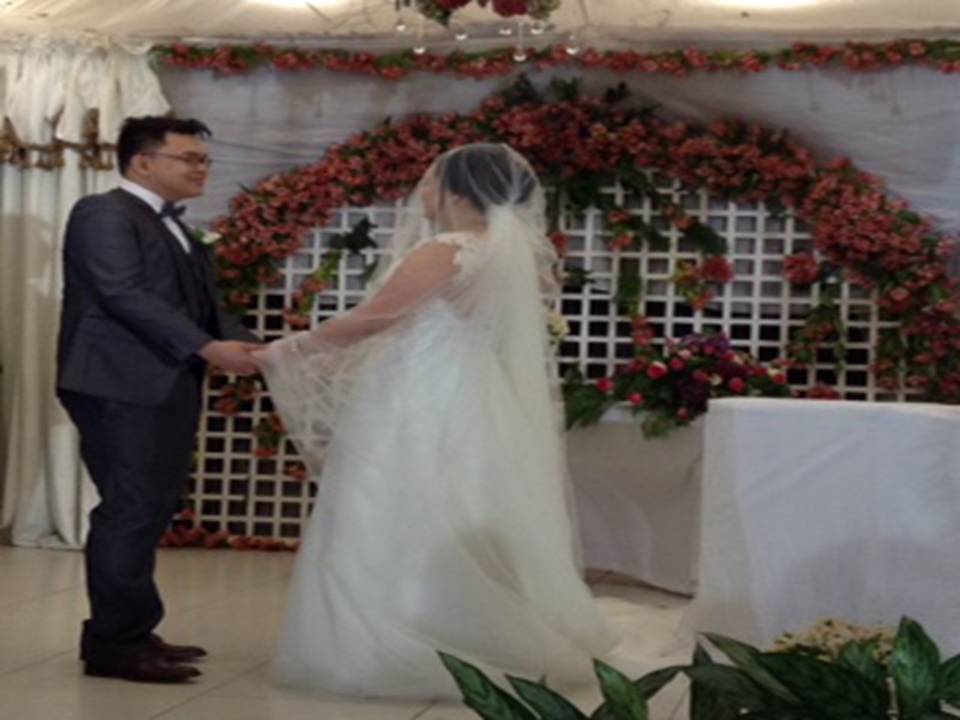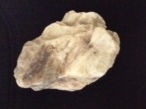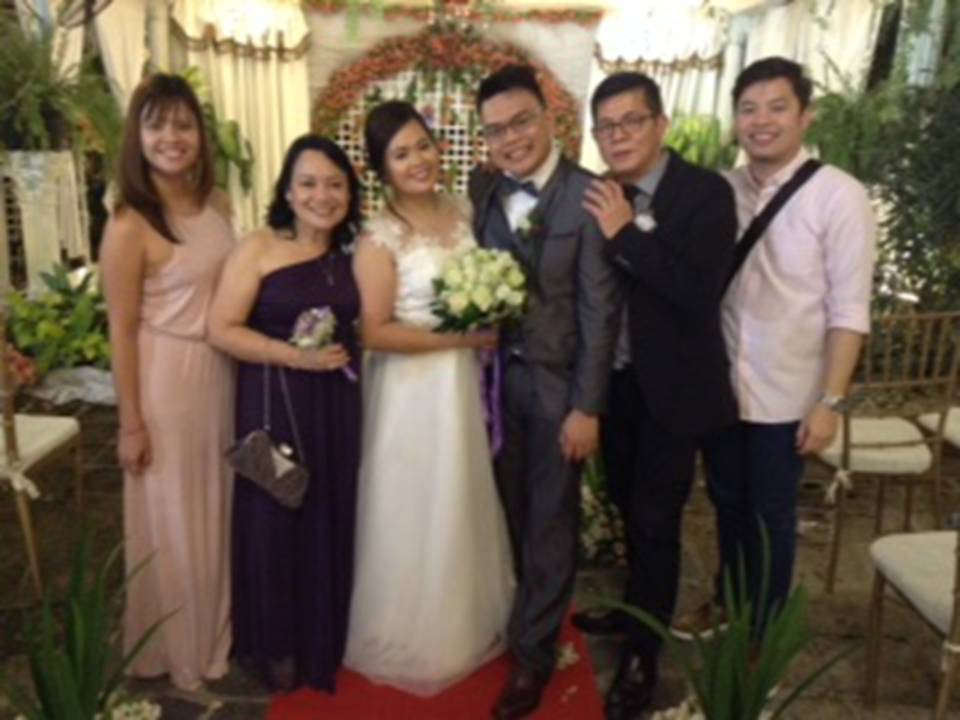The Hourglass
- Details
- Category: Teachings & Articles
- Published: Sunday, 03 December 2017 03:48
- Hits: 5144
The Hourglass
RJ and Pearl Remetion Wedding
Blue Gardens, 22 Samonte Street, corner
Zuzuaregui Road,Commonwealth Avenue, Q.C.
November 30, 2017 (Thursday) 3:30 PM
Edited: December 02, 2017; Saturday; 8:00 A.M.
Sometimes the little moment means the most
(picture1)
Pearl the bride of RJ is passing by under the floral canopy
Glass-smashing
What do the Greek and the Jew have thing in common during marriage ceremony? It is the glass-smashing. I’ve been to Greece once and to Israel twice. At the wedding ceremony, the Greek smash wine-glasses in the same way the Jew does. What is the significance?
According to Detraci Regular (2017)m “Have a Smashing Time in Greece”.
Greeks smashing plates to accompany musicians are mental image of Greece practically as common as the sight of the Parthenon. But if it were really as common in Greece as foreigners believe, there wouldn't be a saucer left intact in the entire country. How did this noisy custom get started?
(picture2)
In ancient Greece, it says that plate smashing may be a survival of the ancient custom of ritually "killing" the ceramic vessels used for feasts commemorating the dead.
One, the voluntary breaking of plates, which is a type of controlled loss, may also have helped participants in dealing with the deaths of their loved ones, a loss which they could not control.
Similar offerings may also have been presented at other times to include the dead in festival proceedings, with the result that this custom for the dead began to be tied in with all kinds of celebrations.
Second, Once you use them, then throw them away. And this speaks of one’s wealth or economic status of a person that you don’t need the washing of used plates and glass and you merely throw them away to the trash bins.
Third, a marketing strategy. One also has to be suspicious of the ancient wandering potters who used to travel from village to village making their wares wherever the clay was good and there was enough wood to fire up a kiln. Could the first people to introduce the locals to this exciting custom have been the potters themselves? Could this custom of breaking plates at parties simply have its origins in a shrewd ancient marketing ploy?
In ancient Israel, a similar breaking of glass is being practiced as well at a Jewish Wedding
If the so-called “glass –breaking” or “plate-smashing” has ancient and medieval significance, what is the relationship of these things to us, to this very day?
Jewish Wedding Symbols
While wedding ceremonies vary, the common features of a Jewish wedding includes the following:
-
a ketubah (marriage contract) which is signed by two witnesses,
-
a wedding canopy (chuppah or huppah),
-
a ring owned by the groom that is given to the bride under the canopy. We call it bridal arch normally adorned with flowers.
-
and the breaking of a glass.
Two Distinct Stages of Jewish Wedding
Technically, the Jewish wedding process has two distinct stages:
-
Kiddushin (sanctification or dedication, also called erusin or betrothal in Hebrew) like Esther who have gone through 6-months of purification (Esther 2:12) before she was given as a wife to the king and nissuin (marriage), when the couple start their life together. The first stage prohibits the woman to all other men, requiring a religious divorce (get) to dissolve, and the final stage permits the couple to each other.
-
Chuppah or huppah. The ceremony that accomplishes nisuin.
The Nissuin is the second of the two ceremonies. The substance of nissuin, the actual marriage ceremony, are seven blessings that reflect the themes of creation, joy, and bride and groom according to Rabbi Daniel Gordis.
The contemporary Jewish wedding ceremony comprises two ancient ceremonies that used to be separated by about a year–erusin, or betrothal (engagement), and nissuin, the actual marriage ( Excerpted with permission from Celebration and Renewal: Rites of Passage in Judaism edited by Rela Mintz Geffen (Jewish Publication Society).
Immediately following the reading of the ketubah (the marriage contract), the second ceremony begins. This ceremony involves the recitation of seven blessings and hence is commonly referred to as the Sheva Berakhot (See below “Seven Blessings). The text of the liturgy is as follows:
Breaking the Glass at a Jewish Wedding
“Why the Jewish wedding ceremony ends with a famous bang, “ by Anita Diamant.
The Jewish wedding ceremony ends with a famous bang. Stomping on a glass is one of the best-known features of Jewish weddings. Traditionally, the groom did the deed; today the couple often share the honor/pleasure, smashing one or two napkin-wrapped glasses.
Few Jewish symbols have a single explanation, and this one is downright kaleidoscopic. The custom dates back to the writing of the Mar bar Rabina made a marriage feast for his son. He observed that the rabbis present were very gay. So he seized an expensive goblet worth 400 zuzim and broke it before them. Thus he made them sober. (Berakhot 5:2 )
In other words, where there is rejoicing, there should be trembling.
By the Middle Ages, synagogue facades in Germany were inlaid with a special stone for the express purpose of smashing a glass at the end of weddings. However, its interpretation changed somewhat by the 14th century, when, according to Maurice Lamm’s The Jewish Way in Love and Marriage, it was viewed as a reminder of the destruction of the Temple in Jerusalem. Either way, the lesson is that even at the height of personal joy, we recall the pain and losses suffered by the Jewish people and remember a world in need of healing.
The fragility of glass suggests the frailty of human relationships. Since even the strongest love is subject to disintegration ( breaking) , the glass is broken as a kind of incantation ( spell, magic)
“As this glass shatters, so may our marriage never break.”
(picture3)
A broken glass (taken from the internet)
Loud noises are a time-honoured method for frightening and appeasing demons that are attracted to beautiful and fortunate people, such as the happy couple beneath the huppah (also commonly spelled ).
Marriage is a covenant, which in Judaism is made by breaking or cutting something. At Sinai, tablets were broken; at a wedding, broken glass “cuts” the covenant.
Breaking the glass also has sexual connotations, as it prefigures the release of sexual union, which is not only permitted to married couples but also required of them. For centuries breaking the glass implicitly symbolized breaking the hymen, which is why it was so important that the groom succeed.
The crash of glass ends the hush of mythic time under the huppah, and the world rushes in. Everyone exhales, claps and shouts, “Mazel tov!” The celebration begins.
You can break any kind of glass: old, new, borrowed, or blue. Whatever you choose, it should be well wrapped to prevent injury. A heavy cloth napkin is standard, but you can buy a satin pouch or a velvet bag. (Some artisans fashion mementoes out of the shards.) While a lightbulb wrapped in a linen napkin might make a louder pop, it seems like a poor stand-in for such a rich and ancient symbol.
Excerpted with permission from The Jewish Wedding Now (Simon & Schuster)
Congratulatory Remarks:
On the wedding day of RJ and Pearl, I was tasked to give a Congratulatory Remarks to the newly wedded couple and what immediately came to my mind is this Scripture that says: “ Mary was espoused to Joseph” (Matthew 1:18/ KJV).
The word “espoused” is translated in several ways like “engaged” in ISV and NET; “promised” in Amplified Bible; “pledged’ in NIV and “betrothed” in ESV.
Espoused (betrothed – KJV) I Greek “mnesteuo” to woo her in marriage, to be promised in marriage.
(picture4)
RJ finds God’s souvenir, Pearl.
Proverbs 18;22, “Whoso findeth a wife findeth a good thing, and obtained favour of the Lord.” Favour” from Hebrew “ratson”:means “pleasure or delight or acceptance.”
Origin:
French, literally, act of remembering; from Middle French, from (se) souvenir to remember; from Latin subvenire to come.
Webster defined souvenir as memento, reminder, remembrance, token, memorial, commemorative or keepsake.
Ancient, Medieval, Present
How the ancient and medieval wedding of glass crashing is relevant today? Let me first speak about this word “souvenir.”
What is souvenir to you?
To RJ, that little moment means the most. His most precious souvenir is Pearl. Teary-eyed, he expresses his gratitude to the Lord in search a meaning for his life that he found from Pearl. Likewise Pearl reciprocated his concern and ardent love.
But life in marriage is like an hourglass. Eventually everything hits the rocks and all you have to do is to void it out until something beautifully meaningful comes in. Marriage is not the end and it merely a beginning of yet another life journey. Marriage is made not born. The same thing goes into a husband-and-wife relationship.
Souvenir
People are fond of souvenir that acts as a remembrance to someone or something. It serves as reminder to many just like why people love to take some take pictures to every memorable place or thing or anything else. To some places I have gone through; a city can be famous for something it is locally produced, so I bought myself these stuff as souvenirs :
-
London - Mark and Spencer products (Harrods is for the rich ones)
-
Egypt - papyrus
-
Italy - Gucci
-
France - YSL
-
Amsterdam – Diamond.
-
Switzerland - Bally Shoes, Longines Watch
-
To whom the souvenir must be given, to the girl or to the boy?
I normally collect before table napkins, matches, ash tray, flags, commemorative stuff, and others. When my cousin was fascinated and mesmerized on the framed papyrus I bought from Egypt, she begged me to buy it but refused. Why? It is a souvenir. You don’t give away souvenir nor sell them. It is a stuff that bring good recollection that has been a part of you.
When the Scripture that says “And Mary was espoused to Joseph,” the word “espoused” is interpreted as “souvenir”. To be exact it means “to give as a souvenir” in marriage.
(picture)
A stone taken from Mt. Sinai as a souvenir. For me souvenir is non negotiable, not for sale, none transferable. In the same way the bride is a souvenir for Christ's return.
The stone was taken from Mt. Sinai, Egypt in May 2017
Since the Church is referred as the Bride, this Bride is the souvenir that the Father has given to the Groom. And Christ as Groom will always be reminded of the souvenir that is given for Him as a keepsake, a reminder for His Return. To this very day, the Church still stands as souvenir to Christ. The Bride is a souvenir or a token for Christ’s returns. It is mind-boggling that Christ’s return is because I am pledged to Him as souvenir or as His Bride. Christ’s 2nd Coming or Return as a Groom is primarily for the pledge or souvenir made
(picture5)
It is fitting to say that “Pearl is given as souvenir to RJ”
And the Ketubah or the Marriage Contract is what the Bride only can hold on for the coming of the Groom. The ketubah or the marriage contract is basically designed for the bride and not to the groom that in the event that the husband will divorce the wife the advantages is preferably given to the woman and not to the man. While the woman can withdraw herself from the pledge, the man cannot divorce her (except in the ground of adultery) because she is a gift from the father.
(picture6)
READINGS:
-
Mary’s Betrothal (Matthew 1:18)
-
Enmity between the woman and the devil (Genesis 3:13-15)
-
Prophetic birth of the male child ( Isaiah 7:14; Matt. 1:18-21)
-
Amazing love is displayed when the Father gave His only Son to the sinner-bride (John 3:16) like the priest Hosea to a prostitute to be his wife whose name is Gomer (Hosea 1:2-3). The purification of a sinner-bride is being picture in Ephesians 5:25-26.
NOTES:
Chuppah or Huppah
A chuppah, also huppah, chipe, chupah, or chuppa, is a canopy under which a Jewish couple stand during their wedding ceremony. It consists of a cloth or sheet, sometimes a tallit, stretched or supported over four poles, or sometimes manually held up by attendants to the ceremony. A chuppah symbolizes the home that the couple will build together.
Sheva Berakhot (The Seven Blessings)
-
Praised are You, O Lord our God, King of the Universe, Creator of the fruit of the vine.
-
Praised are You, O Lord our God, King of the Universe, Who created all things for Your glory.
-
Praised are You, O Lord our God, King of the Universe, Creator of man.
-
Praised are You, O Lord our God, King of the Universe, Who created man and woman in Your image, fashioning woman from man as his mate, that together they might perpetuate life. Praised are You, O Lord, Creator of man.
-
May Zion rejoice as her children are restored to her in joy. Praised are You, O Lord, Who causes Zion to rejoice at her children’s return.
-
Grant perfect joy to these loving companions, as You did to the first man and woman in the Garden of Eden. Praised are You, O Lord, who grants the joy of bride and groom.
-
Praised are You, O Lord our God, King of the Universe, who created joy and gladness, bride and groom, mirth, song, delight and rejoicing, love and harmony, peace and companionship. O Lord our God, may there ever be heard in the cities of Judah and in the streets of Jerusalem voices of joy and gladness, voices of bride and groom, the jubilant voices of those joined in marriage under the bridal canopy, the voices of young people feasting and singing. Praised are You, O Lord, Who causes the groom to rejoice with his bride.
Mar Bar Ravina
Mar Bar Ravina is a fourth-century Babylonian amora, famous for his saintly character. In his youth, he was carefully tended by his mother, who provided him with clean garments every day, so that he could study in comfort (Er. 65a). Although well-to-do, he lived austerely, fasting by day except on Pentecost, Purim, and the eve of the Day of Atonement (Pes. 68b).
At his wedding, a note of seriousness was struck by Rav Hamnuna Zuta who, when asked to sing for the guests, chanted to them, "Alas for us that we are to die" (Ber. 31a). An even sadder note was injected at his son's wedding when Mar, seeing that the company was in a merry mood, deliberately broke a precious cup to dampen their spirit (Ber. 30b–31a). This is probably the origin of the custom of breaking a cup at a Jewish wedding ceremony.
He held that even Gentiles who observed the seven Noachide laws did not thereby earn any heavenly reward (Av. Zar. 2b–3a). He also had an extremely low opinion of Balaam – the arch-prophet of the Gentile world – whom he charged with bestiality (Sanh. 105a) and singled out as the only major sinner against whom biblical passages could be expounded so as to discredit him (Sanh. 106b). Mar bar Ravina had a reputation as a pious, God-fearing man (Ber. 39b; Shab. 61a), who regarded the profanation of God's name as the most heinous sin (Kid. 40a). He was also credited with miraculous escapes from grave perils (Ber. 54a). Characteristic of his piety was his prayer which is still recited at the conclusion of the Eighteen Benedictions: "O my God, keep my tongue from evil and my lips from speaking guile. And to them that curse me may my soul be silent; yea, let my soul be as the dust to all. Open my heart in thy law, and let my soul pursue thy commandments …" (Ber. 17a). By Hyman, Toledot, 900f.; Ḥ. Albeck, Mavo la-Talmudim (1969), 368.










